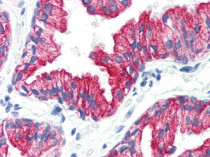ARG62983
anti-Cytokeratin 8 antibody [C-43]
anti-Cytokeratin 8 antibody [C-43] for ICC/IF,IHC-Formalin-fixed paraffin-embedded sections,Immunoprecipitation,Western blot and Human,Bovine,Pig,Rabbit,Sheep
Cancer antibody; Signaling Transduction antibody
Overview
| Product Description | Mouse Monoclonal antibody [C-43] recognizes Cytokeratin 8 |
|---|---|
| Tested Reactivity | Hu, Bov, Pig, Rb, Sheep |
| Species Does Not React With | Ms, Rat, Chk, Hm, Xenopus laevis |
| Tested Application | ICC/IF, IHC-P, IP, WB |
| Specificity | The clone C-43 reacts with Cytokeratin 8 (52.5 kDa). Cytokeratins are a member of intermediate filaments subfamily represented in epithelial tissues. |
| Host | Mouse |
| Clonality | Monoclonal |
| Clone | C-43 |
| Isotype | IgG1 |
| Target Name | Cytokeratin 8 |
| Antigen Species | Human |
| Immunogen | Cytoskeleton preparation from HeLa human cervix carcinoma cell line. |
| Conjugation | Un-conjugated |
| Alternate Names | Keratin, type II cytoskeletal 8; KO; CYK8; CK-8; Type-II keratin Kb8; K2C8; CARD2; Keratin-8; K8; CK8; Cytokeratin-8 |
Application Instructions
| Application Suggestion |
|
||||||||||
|---|---|---|---|---|---|---|---|---|---|---|---|
| Application Note | * The dilutions indicate recommended starting dilutions and the optimal dilutions or concentrations should be determined by the scientist. | ||||||||||
| Positive Control | IHC-P: Prostate |
Properties
| Form | Liquid |
|---|---|
| Purification | Purified from hybridoma culture supernatant by protein A-affinity chromatography. |
| Purity | > 95% (by SDS-PAGE) |
| Buffer | PBS (pH 7.4) and 15 mM Sodium azide |
| Preservative | 15 mM Sodium azide |
| Concentration | 1 mg/ml |
| Storage Instruction | For continuous use, store undiluted antibody at 2-8°C for up to a week. For long-term storage, aliquot and store at -20°C or below. Storage in frost free freezers is not recommended. Avoid repeated freeze/thaw cycles. Suggest spin the vial prior to opening. The antibody solution should be gently mixed before use. |
| Note | For laboratory research only, not for drug, diagnostic or other use. |
Bioinformation
| Database Links | |
|---|---|
| Gene Symbol | KRT8 |
| Gene Full Name | keratin 8, type II |
| Background | Cytokeratins are a subfamily of intermediate filaments and characterized by remarkable biochemical diversity. Cytokeratins are represented in epithelial tissues by at least 20 different polypeptides, molecular weight between 40 kDa and 68 kDa. The individual cytokeratin polypeptides are designated 1 to 20 and divided into the type I (acidic cytokeratins 9-20) and type II (basic to neutral cytokeratins 1-8) families. |
| Function | Together with KRT19, helps to link the contractile apparatus to dystrophin at the costameres of striated muscle. [UniProt] |
| Research Area | Cancer antibody; Signaling Transduction antibody |
| Calculated MW | 54 kDa |
| PTM | Phosphorylation on serine residues is enhanced during EGF stimulation and mitosis. Ser-74 phosphorylation plays an important role in keratin filament reorganization. O-glycosylated. O-GlcNAcylation at multiple sites increases solubility, and decreases stability by inducing proteasomal degradation. O-glycosylated (O-GlcNAcylated), in a cell cycle-dependent manner. |
Images (2) Click the Picture to Zoom In
-
ARG62983 anti-Cytokeratin 8 antibody [C-43] IHC-P image
Immunohistochemistry: Paraffin-embedded Human prostate tissue stained with ARG62983 anti-Cytokeratin 8 antibody [C-43].
-
ARG62983 anti-Cytokeratin 8 antibody [C-43] WB image
Western blot: HeLa cell lysate stained with ARG62983 anti-Cytokeratin 8 antibody [C-43], in reducing conditions.
Clone References









